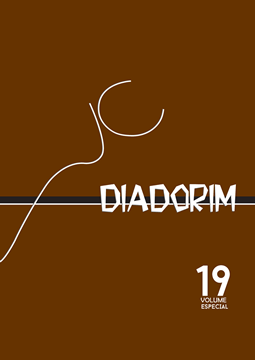Stative Morpheme In Shimakonde, An Anticausative Morpheme?
DOI:
https://doi.org/10.35520/diadorim.2017.v19n0a13610Abstract
Tis paper aims to describe the syntax of the constructions that present the verbal extensions {-ik-} and {-uk-} and their allomorphs in Shimakonde, a Bantu language classifed as P23 in the Guthrie classifcation (GUTHRIE 1967-71). Tis language is spoken in the northern regions of Mozambique and Tanzania. Tese verbal extensions are reported in literature under the labels of stative, impositive, pseudo-passive, neuter, and quasi-passive (DOKE, 1947; SATYO, 1985; MCHOMBO, 1993; DUBINSKY & SIMANGO, 1996; BENTLEY & KULEMEKA, 2001; LIPHOLA, 2001; NGUNGA, 2004; KHUMALO, 2009; LEACH, 2010; LANGA, 2013). Te addition of the {-ik-} or {-uk-} morphemes to the verb structure usually demotes or suppresses the external argument, turning a basically transitive predicate into an intransitive one. Tis paper aims to investigate in Shimakonde if alternations from a dyadic to a monadic predicate, through the use of one of the aforementioned morphemes, are instances of the phenomenon known in literature as causative/ anticausative alternation (HASPELMATH, 1987, 1993; LEVIN & RAPPAPORT HOVAV, 1992, 1995; NAVES, 1998, 2005; VAN HOUT, 2004; OLIVEIRA, 2011; KALLULLI, 2007). In order to do so, I analyze the grammatical role of this morpheme with two Shimakonde native consultants from different Mozambique districts (Mocimboa da Praia and Montepuez). Te feldwork activities consisted of translations of sentences from Portuguese to Shimakonde, testing the grammaticality of the proposed sentences. In order to examine the data that were collected, I adopted the Alexiadou, Anagnostopoulou and Schäfer (2006) refnement of the verbal categories by Levin & Rappaport Hovav (1992, 1995). One of the results obtained is that the verbal extensions display an atelic reading (giving rise to stative interpretation) or a telic reading (giving rise to anticausative or passive interpretation). To account for the different interpretations in these constructions, I propose distinct associations between Asp head and Voice head in accordance with Kratzer (1996), Pylkkänen (2002), van Hout (2004), and Oliveira (2010).Downloads
Published
Issue
Section
License
Copyright transfer -- Authorization to publication
If the submitted article is approved for publication, it is already agreed that the author authorizes UFRJ to reproduce it and publish it in Diadorim: revista de estudos linguísticos e literários, the terms "reproduction" and "publication" being understood as defined respectively by items VI and I of article 5 of Law 9610/98. The article can be accessed both by the World Wide Web (WWW) and by the printed version, with free consultation and reproduction of a copy of the article for the own use of those who consult. This authorization of publication is not limited in time, and UFRJ is responsible for maintaining the identification of the author of the article.

The journal Diadorim: revista de estudos linguísticos e literários is licensed under a Creative Commons Attribuition-NonCommercial 4.0 International (CC BY-NC 4.0).

